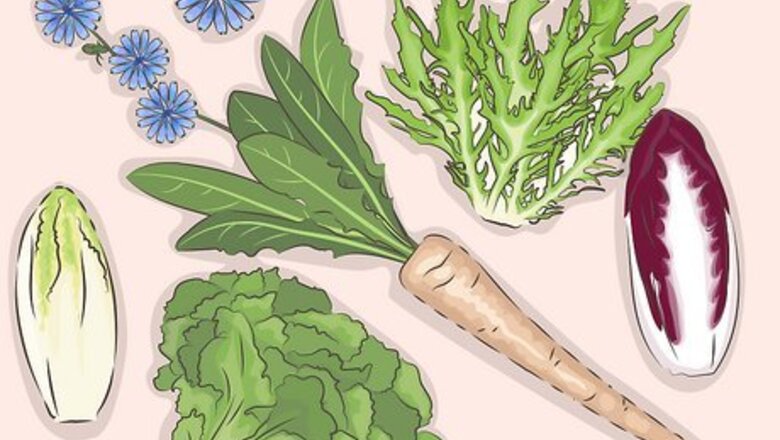
views
- To make chicory coffee, chop chicory root and roast it. Then, grind it and brew the powder as you would coffee.
- Wash the leaves and add them to your favorite salad. The slight bitterness is great with rich foods like creamy cheese, nuts, and avocados.
- Roast or sauté whole or halved chicory leaves and serve them with creamy sauces or cheese to make a great meal or side.
What is chicory and how do I choose it?
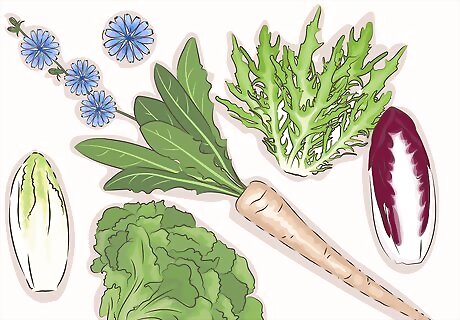
Chicory is an herbaceous plant that grows wild or can be cultivated. In the wild, it's a leafy plant with a tall scraggly stem that sends out small pale blue flowers. At the store or market, chicory includes a number of plants that you're probably familiar with: Curly endive or frisée Belgian endive Radicchio Escarole

Forage for chicory or shop for it during the winter months. If you're foraging or harvesting chicory, don't forget to dig up the root since you can cook it along with the leaves. If you're buying chicory from the market, look for crisp leaves that are tightly packed. Avoid chicory that has signs of insect damage like holes from where insects ate the leaves. Sometimes, you can find it for sale in warmer months, but chicory thrives during the winter.
Chicory Root Coffee

Wash and slice the roots. Scrub them with a vegetable brush under running water until the roots are clean and place them on a cutting board. Use a sharp knife to carefully trim the ends and slice the roots into pieces that are less than 1 in (2.5 cm) in size. You can use store bought chicory roots or forage for them, although chicory roots grow deep in compacted soil, so this can be a workout. Brewing chicory root coffee is a good way to help you reduce coffee consumption.
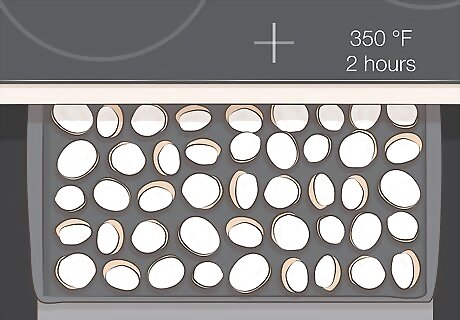
Bake the chicory roots in a 350 °F (177 °C) oven for 2 hours. Spread the pieces of chicory root onto a baking sheet so they're in a single layer. Then, put them in the oven to roast until they're totally dry. If your oven runs hot, drop the oven temperature to 200 °F (93 °C).

Grind the roots into a powder. Let the roasted chicory root cool completely. Then, transfer the pieces to a coffee grinder, spice grinder, or food processor. Blend the pieces into a powder that's about the same consistency as coffee.

Brew the chicory powder as a coffee replacement. Chicory powder is most commonly used to make coffee; to brew chicory coffee, just substitute the chicory powder for coffee grounds and use your preferred coffee brewing method. If you don't enjoy the taste of pure chicory, brew equal parts ground chicory and regular ground coffee. Add a spoonful of chicory powder to smoothies or granola bars if you want extra fiber. Not only is chicory root caffeine-free, but it contains prebiotics that helps keep your gut bacteria healthy. Store the ground chicory root in an airtight container in the fridge or pantry for up to 1 year.
Chicory Leaf Salads and Salsas

Add chicory leaves to any salad for a slightly bitter flavor. Under the bitterness, you'll taste a slightly sweet note, so it makes any salad a lot more interesting to eat! Choose firm green leaves and wash and dry them thoroughly. Then, tear the leaves into bite-size pieces. Use any type of chicory—radicchio adds a little crunch, frisée looks beautiful in a mixed salad, and escarole looks like lettuce but adds a slightly peppery taste. Make a garden salad with chicory to go with fish or roast chicken—the salad really complements these dishes. Start by adding a small amount, since the bitterness might be too much for some tastes.

Add chicory leaves to a shrimp and arugula salad. Heat 3 tablespoons (44 ml) of olive oil, 1 tablespoon (10 g) minced garlic, one chopped onion, and 1/4 cup (40 g) chopped scallions in a skillet over medium heat for 3 minutes. Add ⁄4 pound (340 g) of shrimp and sauté the shrimp for 2 more minutes or until the shrimp are cooked. Then, place 2 cups (60 g) of chicory leaves (like escarole) and 1/2 cup (10 g) of arugula on a serving plate and spoon the shrimp on top. Squeeze a little lemon juice and scatter fresh herbs like parsley and cilantro over the salad to add brightness.

Make a chicory salad with avocado and grapefruit salsa. Cut 1 avocado and 1 grapefruit into cubes and toss them with a splash of olive oil, 1 finely chopped red chili, a handful of chopped cilantro, and salt and pepper to taste. Then, arrange the leaves from 2 heads of chicory (like endive) on a serving plate and spoon the avocado grapefruit salsa over it. Serve the salad right away for the best texture. The mild creaminess of avocado balances out the bitter component of chicory while the grapefruit brings out its bittersweet flavors.

Make a crunchy chicory salad with blue cheese and walnuts. Cut a head of radicchio into 1 in (2.5 cm) pieces and cut 2 heads of Belgian endives into ⁄2 in (1.3 cm) pieces. Toss them with your favorite vinaigrette, 1 cup (117 g) of toasted walnuts, and 1/2 cup (56 g) of blue cheese just before serving. Try a balsamic or Dijon mustard vinaigrette. If you enjoy fruity flavors, raspberry vinaigrette would be good, too! For a fancier presentation, add a few whole leaves of Belgian endive.
Chicory Cooking Methods

Blanch the chicory if you want to remove the bitterness. Set a bowl of ice water next to the stove and bring a pot of water to a boil. Add as much chicory as you'd like to prepare—whole or torn into leaves. Simmer the chicory for 2 minutes. Then, use a slotted spoon to transfer the chicory to the bowl of ice water and leave it for 1 minute before you drain it. To remove even more bitterness, drain the water and repeat the process 1 or 2 more times. Add the blanched chicory to a salad or cook with them—sauté, stir fry, or roast chicory that you've blanched.
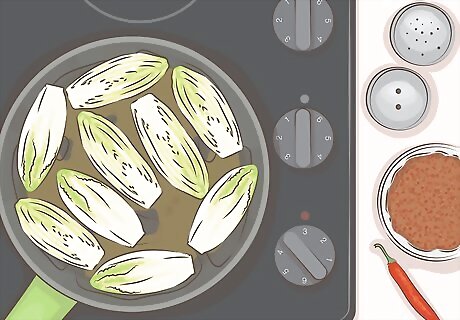
Sauté chicory for a slightly caramelized flavor. Heat a drizzle of olive oil in a large skillet over medium-high heat. Then, slice a head of chicory in half and lay the flat sides in the skillet. If you prefer loose leaves, pull them off of the head before you add them to the skillet. Stir and cook the chicory for about 2 minutes or it has softened. Flavor the sautéed chicory with your favorite seasonings. In addition to the classic salt and pepper, you could use red chili flakes, curry powder, or ginger. Add sautéed chicory to scrambled eggs for a healthy boost to your breakfast plate. Don't forget to add chopped red onions and garlic for even more flavor. Try sautéed chicory in grain bowls for a nutritious way to add greens to your meal.

Braise chicory halves to make them extra tender. Cut heads of chicory in half and blanch them for 2 minutes to remove some bitterness. Heat a drizzle of olive oil or butter in a skillet over medium heat and add the chicory. Cook it for 5 minutes. Then, turn the halves over and add enough chicken stock or water to come halfway up the sides. Turn the heat down to low once the liquid simmers and stick a lid on the pot. Cook the chicory for 20 minutes or until it's totally tender. Add any ingredients you like to the braising liquid—add a little garlic and lemon juice, or replace the liquid with white wine.

Roast whole chicory for a decadent side or meal. Treat chicory like cabbage and roast whole heads in the oven until they're fall-apart tender. Bake the chicory heads in a 395 °F (202 °C) oven for 25 to 30 minutes. Keep in mind that smaller heads of chicory will cook faster than firm or large heads. Chicory is delicious when you wrap it with ham or cover it with a creamy white sauce before you roast it.
Can I do anything to reduce the bitterness?
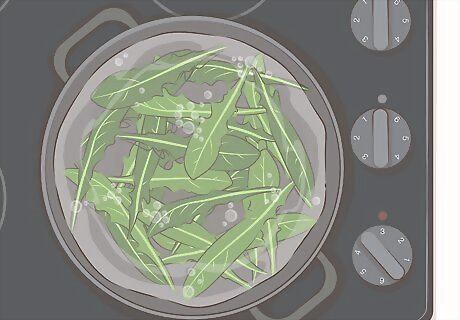
Yes—cook the chicory or blanch it before you add it to a meal. While you can eat chicory leaves and roots raw, they tend to have a sharp bitter taste. If you want to tone down the bitter flavor, just cook the leaves and roots any way you like. Cooked chicory still has a slightly bitter earthy taste to it, but blanching it more than once or adding sweeter elements like honey dressing can cut back on the bitterness.
How do I store chicory?

Wrap unwashed chicory in a paper towel and refrigerate it for up to 1 week. To help your chicory stay fresh longer, store it in the crisper bin. If you're storing frisée, rinse and drain it well before you wrap it in the paper towel. Then, stick it in a plastic bag before you refrigerate it. Keep in mind that more tender varieties of chicory, like escarole, can wilt more quickly than hardier chicory such as radicchio.



















Comments
0 comment